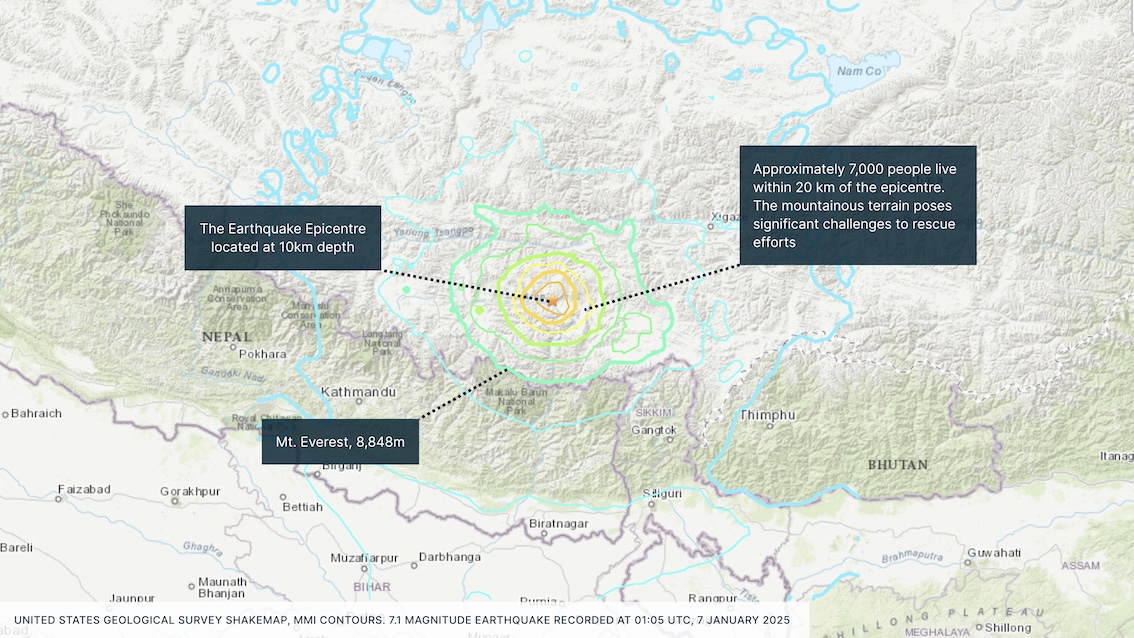Alert+
Evacuations from High-Risk Locations Call +44 (0)1202 308810 or Contact Us →
Widespread Damage in Tibet: Earthquake Strikes Near Mount Everest
Intelligence cut off: 11:00 GMT 07 January 2025
At 09:05 local time (01:05 UTC) on 7 January, a powerful magnitude 7.1 earthquake struck Tingri County in southern Tibet. The epicentre was located approximately 80 kilometres north of Mount Everest at a depth of ten kilometres. The main tremor was followed by aftershocks of above 5.0 magnitude. The earthquake has caused widespread damage across Tingri County, including the city of Shigatse. Tremors were also felt in neighbouring countries, including Nepal and northern India, although no significant damage has so far been reported in these locations.
Initial reports confirm at least 95 fatalities and over 130 injuries, with more than 1,000 buildings damaged or destroyed. While the mountainous Tingri County is scarcely populated, approximately 7,000 people live within 20 kilometres of the epicentre. The city of Shigatse, the second largest in Tibet, has around 800,000 residents.
Local sources reported that the earthquake has disrupted local power and water supplies, and damage to local roadways has also been recorded. In January, the area has daily minimum temperatures of below -15 degrees Celsius, and daily average temperatures of -7.5 degrees.
The Chinese Air Force has initiated rescue efforts and deployed drones to the affected area. At least 1,500 firefighters and rescue workers have also been dispatched, alongside supplies including cotton tents, quilts, and folding beds.

7.1 Magnitude earthquake recorded at 01:05 UTC, 7 January 2025. United States Geological Survey ShakeMap, MMI Contours
SOLACE GLOBAL COMMENT
Geological Context of 2025 Tibet Earthquake
The earthquake is one of the deadliest China has experienced in recent years. On 23 January 2024, a magnitude 7.0 earthquake struck Xinjiang, China. The death count was significantly lower, however, with only three deaths. In 2008, a large earthquake in Sichuan province killed nearly 70,000 people.
Southwestern regions of China are frequently affected by earthquakes. This is largely due to the region lying at the convergence zone of the Indian Plate and Eurasian Plate, which periodically releases tectonic stress as earthquakes. Furthermore, the region has numerous active fault systems including the Longmenshan Fault Zone, which triggered the 2008 earthquake, and the Xianshuihe Fault Zone.
The Lhasa block, also known as the Lhasa terrane, is a significant geological region in southern Tibet, situated between the Bangong-Nujiang suture zone to the north and the Indus–Yarlung Zangbo suture zone to the south. This positioning generates north-south compression, resulting in crustal shortening and uplift, as well as west-east stress, which drives lateral crustal movements. These geological processes play a crucial role in the formation of the Himalayas and significantly impact regional fault systems and seismic activity.
INTELLIGENCE ANALYSIS
Relief Challenges in Tibet: Topography, Aftershocks, and Political Scrutiny
While the United States Geological Survey measured the earthquake’s magnitude as 7.1, the China Earthquake Networks Center recorded a magnitude of 6.8. Differences in earthquake readings is relatively common due to the utilisation of different magnitude scales, algorithms, frequency sensitivity, distance from the epicentre, and the complexity of the fault movement.
Several aftershocks have already been felt in Tibet and Nepal; further aftershocks are highly likely in the coming days. While the aftershocks are unlikely to reach a similar magnitude to the initial earthquake, further aftershocks of approximately 5.0 magnitude may still occur. This could further damage structures that have already been weakened by the initial tremor and hinder relief efforts.
Power and water have been significantly disrupted in the region, which could further exacerbate humanitarian issues as residents cope with the aftermath. More deaths will almost certainly be confirmed as authorities verify fatalities amidst ongoing rescue efforts.
Shigatse, the closest city to the epicentre, is regarded as one of Tibet’s holiest cities and contains the Tashilhunpo Monestary which houses the seat of the Panchen Lama, a central figure in Tibetan Buddhism, second only to the Dalai Lama. It is an important pilgrimage site for Tibetan Buddhists. Furthermore, because of its proximity to the Nepalese border, it is an important trade hub. The earthquake will almost certainly disrupt trade through the region as recovery efforts continue.
The area is also a notable tourist site. Since Tingri county is located at the foot of Mount Everest, tourists often base themselves in the region. Mount Everest sightseeing tours have been cancelled in the aftermath. However, no significant damages were recorded at Mount Everest base camp.
The government’s response to the earthquake is likely to be viewed through the lens of historical Tibetan grievances. Given the mountainous topography of the region and potential aftershocks, relief efforts will likely be hampered, potentially opening the government up for criticism regarding its effectiveness at governing in the region. In the aftermath of the earthquake, there is a realistic possibility that those sympathetic to Tibetan independence will scrutinise the government response and call for self-determination.
Travel Risk Advice: Precautions for Tibet Erthquake Zones
- Closely monitor local news reports and government alerts
- Expect aftershocks. Be prepared to Drop, Cover, and Hold On in case of further tremors.
- During a tremor:
- If outside, avoid entering buildings. Move away from buildings, trees, streetlights, and overhead lines.
- If inside, pick a safe place, such as under a sturdy table or desk, or against an interior wall. Stay away from windows and heavy furniture. Do not leave until the shaking stops.
- If evacuating a building, always use the stairs.
- Be alert to fires and falling debris.
- Adhere to all instructions issued by authorities.
- Follow evacuation orders and travel to government-designated shelters if it is safe to do so.
- Ensure important documents and medications are safely stored.
- Prepare an emergency “go bag” with essentials, including bottled water, batteries, important documents, and medications.
- Confirm flights are operating before checking out of hotels or travelling to the airport.
- Prepare for potential power outages, communication disruptions, and travel delays.
- Avoid damaged buildings and affected areas until authorities declare them safe.
- Management should maintain communication with affected individuals until the situation is fully resolved.

